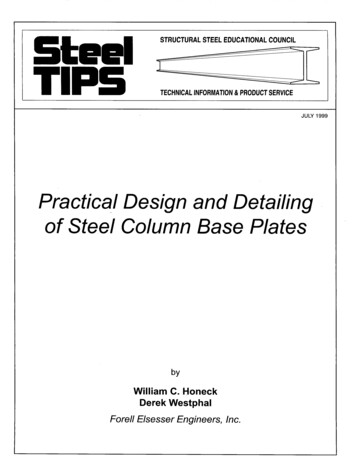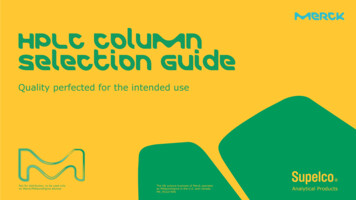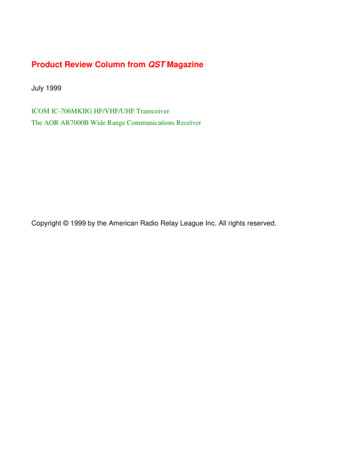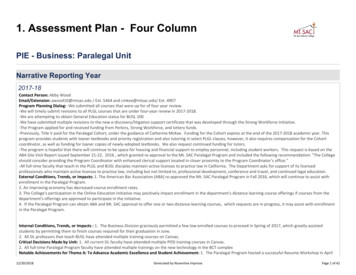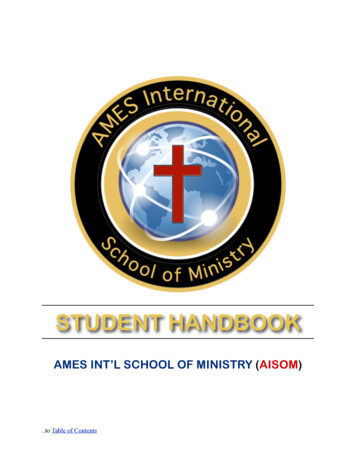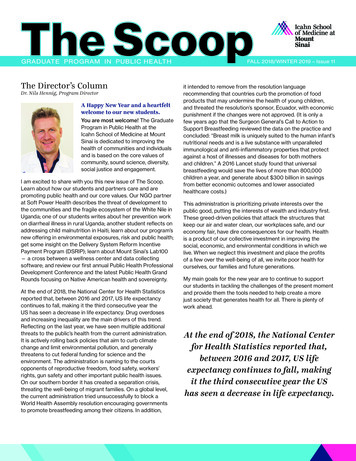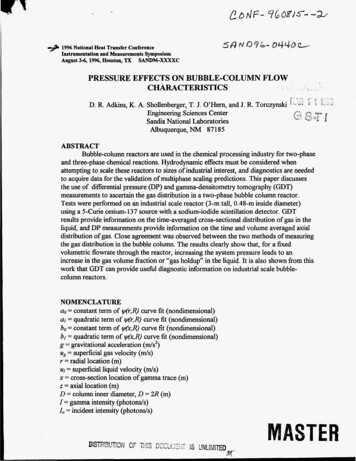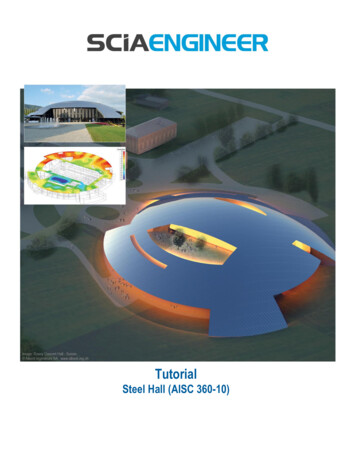
Transcription
BULETINUL INSTITUTULUI POLITEHNIC DIN IAŞIPublicat deUniversitatea Tehnică „Gheorghe Asachi” din IaşiTomul LIX (LXIII), Fasc. 6, 2013SecţiaCONSTRUCŢII. ARHITECTURĂDESIGN OF STEEL COLUMN BASE CONNECTIONS FORLARGE ECCENTRICITIESBYVICTORIA-ELENA ROŞCA*, ELENA-CARMEN TELEMAN, ELENA AXINTEand GEORGETA BĂETU“Gheorghe Asachi” Technical University of IaşiFaculty of Civil Engineering and Building ServicesReceived: November 2, 2013Accepted for publication: November 27, 2013Abstract. In this paper, the concrete underneath the base plate togetherwith the base plate is referred to as “component concrete in compression andbase plate in bending” or in short “concrete in compression”. The strength of theconcrete in compression depends on the concrete base material, the behaviour ofthe grout layer and the complex phenomena in the contact area between the baseplate and the concrete. Models are presented for the determination of theresistance of this component. The models have been validated with tests. In thispaper a brief description of literature reviewed is presented along with theirvarious assumptions adopted during modeling.Key words: base plate; components method; concrete bearing strength.1. IntroductionThe column base connection is one of the critical connections in a steelstructure: it is designed to support gravity loads, bending moments and shearforces. The couple of forces of bearing on the concrete and tension in anchorbolts resists to the external bending moment resulted by fixing the column basein foundation.*Corresponding author: roscave@yahoo.com
138Victoria-Elena Roşca, Elena-Carmen Teleman, Elena Axinte and Georgeta BăetuThe determination of the design value of the external shear force as wellas the value of the design bending moment are often performed independently,assuming there is no significant interaction between them. If the base plateremains in compression, shear force may be transmitted through frictionbetween the grout pad or the concrete in foundation. Large shear forces can beresisted through bearing by concrete, either by directly embedding the columnbase on acertain depth in cast at site concrete or by welding a shear lug at thebottom the base plate, the first being in its turn embedded in cast at siteconcrete.The general behavior and distribution of forces for a column base plateconnection with anchor rods will be elastic until one of the following failuremodes will prevail: formation of a plastic hinge forms in the column, a plasticmechanism in the base plate, crushing of concrete in bearing, yielding of theanchor rods in tension, or tear off of the concrete by the anchor bolts in tension.The failure of the connection mostly consists in brittle fracture of base plate,excessive anchor bolt elongation, unexpected early anchor bolt failure, andconcrete crushing.In statically loaded structures, if the strength is much largerthan the demand, the ductility criterion is not prevailing,the design at limit stateof tensile or shear strength of the anchor rod group being appropriate.Above observations impose an improved understanding of the beahiourof the column-base plate connection under large eccentricities induced bybending moments and the development of more reliable design methodsinsuring in the same time an increased ductility for the connections.2. Existing Design Methods for Base PlatesThe prediction of the behaviour of base plate joint is complex due to thebond between the anchor rods and the concrete base material, the behaviour ofthe bedof mortar layer and the complex evaluation of the stiffness and resistanceof the concrete below the compressed part, due to the contact phenomenabetween the base plate and the concrete.Two general approaches are adopted for the design of base platessubjected to axial load and bending moment. One is based on the elasticbehavior of the material and of all the elements of the connection; the other isbased on the failure modes due to post elastic stresses and deformations.The elastic analysis is based on the assumption of a stiff base plate withfull contact to the concrete base which remains plane and develops stresses andstrains in the elastic range. The elastic approach (Thambiratnam &Paramasivam, 1986; Ballio & Mazzolani, 1983; Salmon & Johnson, 1980) iscovered by all the literature with respect to the approach of designing momentresistant joints.The strain distribution is linear and the result is that the strain in theanchor bolt is dependent on the strain distribution in the bearing area. This is
Bul. Inst. Polit. Iaşi, t. LIX (LXIII), f. 6, 2013139not consistent with actual behavior.In fact, the force in the bolt and the bearingin the concrete are independent. This approach (Fig. 1 b) is more consistent withthe actual behavior when the results are compared to tests (DeWolf & Sarisley,1980).Fig. 1 – Elastic analysis of steel column foundation designed toaxial load and bending moment: a – theoretical assumption;b – actual behaviour.The design of base plates within elastic theory assumptions often leadsto thick, uneconomical steel plates.A minimized steel consumption for this joint may be achieved byapproaching the plastic design. A plastic distribution of the internal forces forcalculations at the ultimate limit state is adopted for the design of column basesin EN 1993-1-8.3. Eurocode 3 Design Model for Base Plates3.1. Component Method for Base PlatesThe concept adopted by EN 1993-1-8 is to transform the flexible baseplate into an effective rigid plate and to allow the development of stresses in theconcrete foundation that will reach ultimately the resistance to compression in aconcentrated area (Murray, 1983).The main advantage of the component method (Fig. 2) is the ability toallow prediction of the rotational capacity of different types of joints by meansof a single approach, starting with an appropriate identification in parallel withmodeling of all the sources (elements) of both resistance and deformation.
140Victoria-Elena Roşca, Elena-Carmen Teleman, Elena Axinte and Georgeta BăetuThese individual elements are nominated as components (parts of theconnection) and they are assembled, producing a complete model of the joint.Fig. 2 – Eurocode 3 model – components decomposition.In addition, the loading process plays an important role in the behaviourof base plate joints.In the technical literature, two different types of loading processes areusually adopted:a) the first is characterized by an incremental loading, the vertical loadand the bending moment being in direct proportion increased, so that theeccentricity is constant during the loading process;b) conversely, the second one is characterized by a loading processduring which the vertical load is applied in a first loading phase and in thesecond phase the application of an increasing bending moment is carried out upto failure. In this case, the eccentricity is continuously increasing giving rise toan additional non-linearity source in the joint behaviour.For the configuration of the column base plate connection given inFig. 2, according to the procedure proposed by Eurocode 3, three differentcomponent groups are identified in relation with their individual loading: theconcrete in compression, the base plate in bending, the anchor rods intension and the column flange and web in compression.In order to determine whether anchor bolts are necessary, the baseplate dimensions are needed by a preliminary sizing.The application of the component method requires the development ofthe following steps:a) determine the compression force under base plate;b) size the height of compression zone;
Bul. Inst. Polit. Iaşi, t. LIX (LXIII), f. 6, 2013141c) calculate the inner moment resistance.If the resistance of the anchor bolts and the frictional resistance areexceeded, the shear force must be transferred to the foundations in othermanners (the use of shear lugs or the embedment of the column base into thefoundation).3.2. Bearing Strength of the ConcreteTwo assumptions are used in the literature with respect to the resistanceof concrete in compression: the base plate is assumed to be rigid or, it isassumed to be flexible.A rigid base plate connection loaded with axial force is assumed todevelop uniformly distributed stresses under the plate, whilein the case of aflexible plate, the stresses are concentrated around the footprint of the columnsection under the plate (see Fig. 3).Fig. 3 – Flexible base plate modelled as a rigid plate of equivalent area.The grout layer between the base plate and the concrete influences theresistance and the stiffness of this component so its resistance and rigidity areincluded in the whole evaluation of the component.The bearing strength of the concrete underneath the plate is dependenton the size of the concrete block. The allowable stress, fjd , of the joint, accordingEN 1993-1-8 and EN 1992-1-1, is evaluated with the following relationships:f dj j FRdu,Aeff(1)where FRdu is the local design resistance force given in EN 1992-1-1. Accordingto EN 1993-1-8, (2005), the joint coefficient, βj , is taken as 2/3 when the grouthas at least 20% of the characteristic strength of the concrete foundation.The design value for the bearing strength concentrated around thefootprint of the column section under the base plate (Fig. 3), according EN1993-1-8, is obtained from a cantilever with the span c:
142Victoria-Elena Roşca, Elena-Carmen Teleman, Elena Axinte and Georgeta Băetuc tfy3 f jd M 0,(2)where t is the thickness of the base plate.3.3. Simplified DesignThe design starts with assuming an equivalent eccentricity, e, equal tothe moment, M, divided by the external axial force, P. It results then that thebending moment and the external axial force are replaced by equivalent axialforce acting at distance e from the center of the column, as presented in Fig. 4.For small eccentricities, the equivalent axial force is resisted by bearing only.Starting from the translational and rotational equilibrium conditions, thejoint moment resistance, Mj,Rd , is expressed as a function of the load eccentricity,e, as it follows:a) low eccentricity, e zc,rz FM j ,Rd min c ,l ,Rd , zc ,r e 1Fc ,r ,Rd z ,zc,l 1 e (3)b) high eccentricity e zc,rz FM j ,Rd min t ,l ,Rd ,zc ,r 1 eFc ,r ,Rd z ,zt ,l 1 e (4)where Fc,l,Rd is the resistance to compression under the left flange of the column,Fc,r,Rd – the resistance to compression under the right flange of the column, Ft,l,Rd– the resistance to tension located either under the left flange or in the axis ofthe bolt situated at left side and Ft,r,Rd has similar significance with respect to theright side, depending on the sign of the bending moment; finally zc,l, zc,r, zt,l arethe distances from the column axis to the left, respectively to the rightcomponents – flange and bolt (Fig. 4). The distance z is the lever arm of thecouple of forces designed to resist to the combined action of external force andbending moment, being equal with zc,l zc,r, in case of small eccentricity, andequal to zt,l zc,r , in case of big eccentricity (Fig. 4).The resistance of the base plate in tension, Ft,Rd , may be modeled bymeans of an equivalent T-stub element according to the well-known EN 1993-18 formulations.
Bul. Inst. Polit. Iaşi, t. LIX (LXIII), f. 6, 2013143abFig. 4 – Base plate design cases: a – small eccentricity – full platein compression; b – large eccentricity – reduced surface of the baseplate in compression.Therefore, the resistance of the base plate in tension in the absence ofprying forces may be determined with the following relationships: 2 M pl ,1,RdFt ,Rd min ,m Bt ,Rd , (5)where: Mpl,1,Rd is the plastic bending moment of the base plate corresponding totype 1 collapse mechanism, m – the distance between the plastic hinge and thebolt axis and Bt,Rd – the design resistance in tension of the anchor bars.The resistance of the components in compression, Fc,Rd , is given by theminimum value between the bearing resistance of the concrete and theresistance to failure in compression of the column flange and web, as follow: Fc ,Rd min f jd beff leff , M c ,Rd ,hc t fc (6)where: fjd is the resistance in compression of concrete under axial point loads,beff and leff – the effective width and, respectively, length of the compressed Tstub flange, Mc,Rd – the column plastic resistant moment accounting for theinteraction with shear and axial stresses, according to EN 1993-1-8, hc – thecolumn section height and tfc – the column flange thickness (Fig. 5).3.3. Discussion Upon the Components Method Applied for Base PlatesThe validation of this method for the design of column bases in EN1993-1-8 has some limitations. In case of column-base joints subjected to axialload and bending moment, a simplified approach is proposed by the code
144Victoria-Elena Roşca, Elena-Carmen Teleman, Elena Axinte and Georgeta Băetusuggesting to neglect the contribution due to the web of the T-stub. Eurocode 3assumes that the instantaneous center of rotation should be in the axis of thecolumn flange, this being a very conservative hypothesis adopted for theposition of the concrete compression force (Fig.5).Fig. 5 – Position of the actual neutral axis versus Eurocode 3 model.3.4. Bearing Area of the Concrete According to EN 1992-1-1The extension of the compression zone, x (see Fig. 6), may bedetermined based on the allowable stress fjd in the connection according EN1993-1-8 and EN 1992-1-1.In Eurocode 2, x is the distance to the plastic neutral axis, the width ofthe stress block being x (see Fig. 7). Consideration of a rectangular stressdistribution in accordance with Eurocode 2 ( 1) leads to the following eq.:Fc xbeff .(5)Vertical force equilibrium requires thatFt Fc N Ed .(6)Thus the lever arm and the moment resistance of the base plate can bedetermined as follows (Fig. 7):M Ed Fc (d1 0.5 x) N Ed(2d1 L) .2(7)
Bul. Inst. Polit. Iaş
where t is the thickness of the base plate. 3.3. Simplified Design The design starts with assuming an equivalent eccentricity, e, equal to the moment, M, divided by the external axial force, P. It results then that the bending moment and the external axial force are replaced by equivalent axial force acting at distance e from the center of the column, as presented in Fig. 4. For small .
